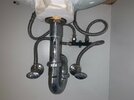After 12 years of turning on the shower, brushing my teeth, then getting in the shower a while later, because it takes an eternity to get hot water in the master bath... (The builder placed the water heater about 10 feet short of literally as far as it could be from the master bath).
I thought this was normal, since I'd never heard of anything else. But I was tired of it. Started doing some research.
(Shower is on 2nd floor, heater in basement)
I installed this:
And, within a day noticed:
1. it works. (water is warm within 10 seconds at shower, and you can get in within 15 seconds).
2. I don't think I need the water pump part.
How do I know?
Well, I set the pump to 4PM to 11PM to start with.
Took a shower at about 10AM yesterday and today, and had hot water within seconds.
The water seems to be circulating based only on heat difference.
I can tell since the cold line is warm under the sink where I installed it.
I didn't get to time, time to warm, before the under sink valve, but I can turn that off and time it in the AM for comparison (it was at LEAST 45+ seconds if not a full min).
Anyway, I've unplugged the pump to 100% confirm it works fine without it, I don't know if I'll remove it to reduce leak points or not yet. The whole casing is metal and would leak tons of heat into my basement. So that's a negative. You can buy just the valve alone:
I installed the valve first, but then installed the pump same day.
Wish I had known having just the valve could have worked.
(Might not work for everyone).
I do wonder if I'll get hot water faster w/the the pump - 10 seconds seems so much nicer than the minute it was before.
I also am concerned that in summer, when the house/basement are warmer, the 'automatic' circulation would not be as effective.
so, I think I'll leave the pump in place, for now. unplugged.
I would like to wrap it in insulation. I'm an efficiency nerd when it saves my wallet!
I thought this was normal, since I'd never heard of anything else. But I was tired of it. Started doing some research.
(Shower is on 2nd floor, heater in basement)
I installed this:
And, within a day noticed:
1. it works. (water is warm within 10 seconds at shower, and you can get in within 15 seconds).
2. I don't think I need the water pump part.
How do I know?
Well, I set the pump to 4PM to 11PM to start with.
Took a shower at about 10AM yesterday and today, and had hot water within seconds.
The water seems to be circulating based only on heat difference.
I can tell since the cold line is warm under the sink where I installed it.
I didn't get to time, time to warm, before the under sink valve, but I can turn that off and time it in the AM for comparison (it was at LEAST 45+ seconds if not a full min).
Anyway, I've unplugged the pump to 100% confirm it works fine without it, I don't know if I'll remove it to reduce leak points or not yet. The whole casing is metal and would leak tons of heat into my basement. So that's a negative. You can buy just the valve alone:
I installed the valve first, but then installed the pump same day.
Wish I had known having just the valve could have worked.
(Might not work for everyone).
I do wonder if I'll get hot water faster w/the the pump - 10 seconds seems so much nicer than the minute it was before.
I also am concerned that in summer, when the house/basement are warmer, the 'automatic' circulation would not be as effective.
so, I think I'll leave the pump in place, for now. unplugged.
I would like to wrap it in insulation. I'm an efficiency nerd when it saves my wallet!



